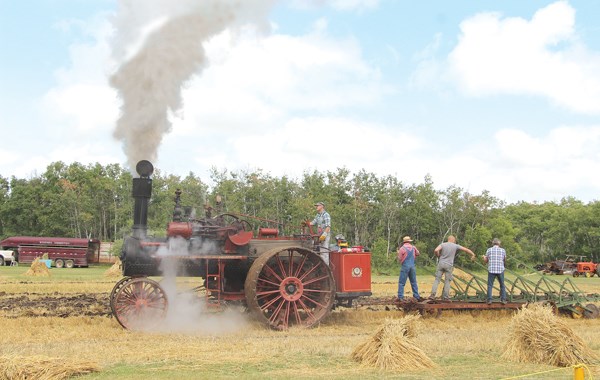It’s big, it’s powerful, it’s over 100 years old, and it’s Matthew Weber’s baby. The Waterloo tractor was one of the tractors working at the Threshermen’s Show and Seniors’ Festival, a steam engine that has been a staple of the event for several years. Weber is one of the engineers who runs it.
Weber is an engineer certified to run a steam engine. It’s regulated by the province and everyone who wants to operate one has to take a test to show they can do so safely. If you have the knowledge to run it, Weber notes, the engine is very safe.
“Of course there always a risk in anything you do, but it’s quite a safe machine if you operate it properly.”
Weber is fascinated by how steam works and that’s why he took the course, took the license test, and now operates steam tractors for the WDM.
“You can’t hear it, but you can see it. It’s a very quiet power... Heat a little bit of water, get that steam and see what you can do with it.”
Running a steam engine also connects you with history and running a tractor that has been around for over 100 years tells you about the people who used it long before you came along.
“I’ve always had a huge interest in and fascination with history, to see how our forefathers worked on this land and the type of equipment that they worked with,” Weber said.
Two engines were operating at the Threshermen’s Show, with the second being a new 109-year-old tractor made by Geiser that just arrived on July 31. The Waterloo remains Weber’s favourite because he was part of bringing it back to life, getting it fully inspected and certified, and working to get it operating again. While the Geiser might be new to the museum, the Waterloo is what got Weber into steam after he had been part of the gas program at the WDM and he helped get it working.
“This engine was shut down for a number of years due to some mechanical issues. It sat idle for about ten years... I was actually be able to be part of this engine right from when it came back on the books.”
Being pieces of history, the tractors don’t have much in the way of parts support, and the service department at Waterloo and Geiser is terrible, largely because it doesn’t exist anymore. Keeping them running can sometimes be a major challenge.
“We have to essentially figure out and write a maintenance manual on these things, because the maintenance and procedures, a lot of it was done by memory by the guys operating it, and those guys aren’t around anymore.”
It takes about 30-40 people within the Western Development Museum to keep their steam fleet going.
If you want to drive the tractor, how do you do it? The important part is getting certified. While you can challenge the test at any time, Weber said, the best way to do it is to take a course through the Western Development Museum. The next steam traction course will be in May 2019 in Moose Jaw. It’s a nine day course with an optional two day weekend for a locomotive upgrade. After that, to operate on WDM property you can take a driver’s test through the WDM.
Weber hopes people do. He wants to see more people volunteering for the WDM overall, whether they’re interested in steam or something else at Threshermen’s show, there is always a need for more people to help make the day work and teach people about the province’s past. He believes we need to keep the traditions they show off every year alive and that needs people.
“If we don’t remember this, don’t respect it, don’t learn about how our ancestors worked and the amount of labour... The knowledge, the get up and go, the drive that these guys had, this is all going to get lost to history books. This engine, you read a book you can’t feel that engine, you can’t explain what it can do, what it does, what it sounds like, what it smells like... Today’s generation needs to see that in action.”



